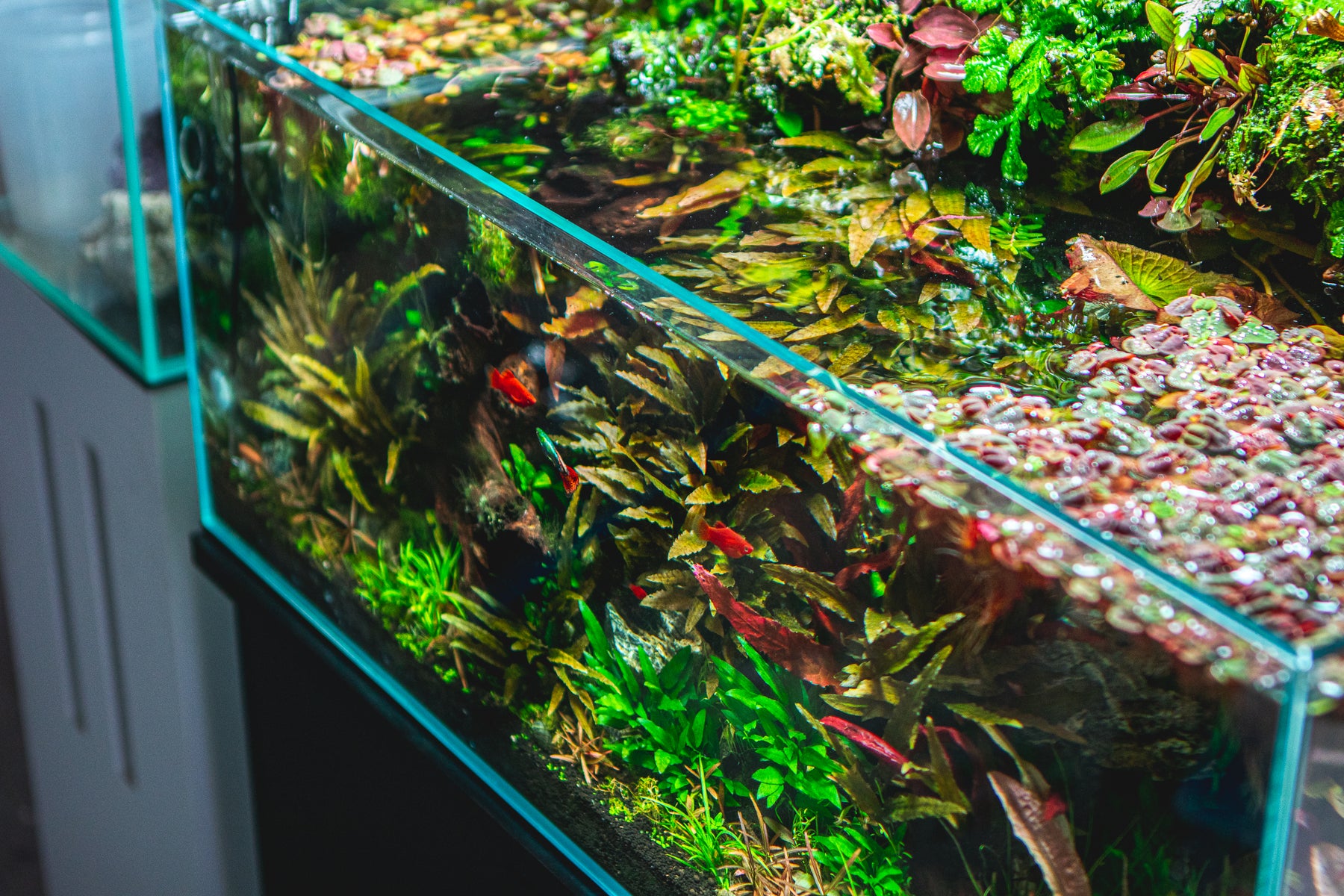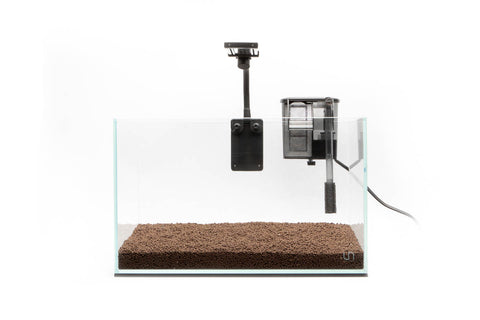
How to Cycle a Fish Tank
Want to make sure your planted aquarium is a success? The first stages of tank setup are critical. It’s helpful to know the science behind what keeps your aquatic plants and their animal friends thriving.
Cycling your tank is by far one of the most important parts of tank setup. In order to keep a balanced and healthy aquarium for fish, shrimp, and plants, then you must know a little about the nitrogen cycle.
This article will go over:
What is the nitrogen cycle?
We will take a closer look at the nitrogen cycle so you can fully understand how nitrogen plays a part in your aquarium. Many of you may remember learning about nitrogen as a kid in school. Nitrogen is a chemical element that makes up about 78% of the Earth’s atmosphere. The majority of living animals use nitrogen for many bodily processes. These processes result in the release of nitrogen in different forms such as ammonia, nitrite, and nitrate, which are toxic in high concentrations (ammonia being the most toxic, then nitrite, then nitrate being the least toxic.)
Nitrogen is a byproduct of protein breakdown. When it comes to your tank, this refers to the breakdown of fish waste, uneaten food, decaying plants, and any other decomposing matter building up in your tank. Produced from this decomposition is ammonia, which converts to nitrite, then nitrate.
This nitrification process occurring in your tank can eventually become harmful to your livestock if imbalanced. A level of ammonia over 0.0 ppm can be dangerous to your tank’s inhabitants.

The Nitrogen Cycle
Why is a cycled tank important?
Typically, in a natural environment with a large body of water, ammonia is quickly diluted and does not harm living organisms in any way… But in your aquarium, the ammonia (most toxic) can easily build up and create an unhealthy living environment for both your plants and animals.
This is why ‘cycling your tank’ is an important part of a healthy aquarium. A cycled tank means that there is an active and balanced nitrogen cycle occurring in the tank. It also means that the beneficial bacteria that enables the nitrification process has established and colonized itself in your tank. In an established, or ‘cycled’ aquarium, ammonia (more toxic) is quickly converted to nitrite (toxic) by the beneficial bacteria that live mostly in the media of the filter. Nitrite is less toxic than ammonia but will still cause harm in high concentrations. The nitrite in the tank will then be converted to nitrate (less toxic) by the beneficial bacteria within the media of the filter. Learn more about the different types of filters and the importance of filtration here.
Although nitrate is the safest form of nitrogen and can be tolerated at higher amounts, it still must be removed through water changes. The best way to remove nitrogen buildup from a tank is to perform water changes often, so keep up those water changes! (Learn more about how to perform water changes the right way--click HERE)
Also, aquatic plants will absorb and use nitrate in order to grow, so having plenty of aquatic plants in your tank will help lower nitrate levels. Having enough plants will help recreate a natural ecosystem and help maintain the chemical balance in your tank.

What’s the best way to cycle my tank?
Now that you completely understand why the nitrogen cycle is important, let’s go over the ways to create a balanced cycle in your aquarium (aka ‘cycle your tank.’)
- Remember: a level of ammonia over 0.0 ppm can be dangerous to your tank’s inhabitants. Make sure to use a freshwater test kit to make sure your tank is completely cycled. A cycled tank should have these parameters:

Fishless Cycles (recommended)
There are several ways to start a nitrogen cycle in your new tank. The methods that we recommend are “fishless cycles.” This refers to the process of growing beneficial bacteria in your tank’s filter before any fish or other animals have been introduced. These methods are more humane than fish-in cycles because they avoid causing unnecessary harm onto your fishy friends.
We have listed the 3 best ways to cycle your aquarium below for you:
1. Set your tank up with substrate and hardscape, then let it run without any livestock (plants, fish, shrimp, etc.) until it is established.
- You will perform occasional “ghost feedings” so the uneaten food will produce ammonia and cause the beneficial bacteria to colonize the tank. Beneficial bacteria will be introduced to your tank from its surrounding environment (coming naturally from the air, your hardscape, substrate, etc.)
- This method is the slowest way to cycle a tank and may take up to 1-2 months.

The most efficient way to cycle a tank is by directly adding bacteria. Here are two ways to add bacteria into your tank:
2. Add liquid nitrifying bacteria.
- Liquid nitrifying bacteria will be added into the tank regularly until the nitrogen cycle is created. Make sure to read instructions on the product used for proper dosing.

Click here for SL Aqua Nitrifying Bacteria
3. Add filter media from an established tank.
- Using pre-established filter media from another tank and placing it in your new tank’s filter is a common way to quickly encourage beneficial bacteria to colonize and cycle your tank properly. Although, make sure to only use media from a trusted source to avoid unwanted pests and pathogens going into your new tank!
- You can also run the new filter on an already established tank (side-by-side with the existing filter) in order to colonize the new filter faster.
- Hint: DO NOT let the filter dry out during the transfer process. Quickly transfer filter media from the established tank to your new tank so the beneficial bacteria does not die from drying out.
Methods 2 & 3 will greatly help cut down the cycling time to 1-3 weeks.

Click here for Aquario Neo Filter Media
Fish-In Cycle (not recommended)
The last way to cycle a tank is called the “fish-in cycle,” a technique that we do not recommend.
This is done by adding a few hardy fish in the tank, and as a result, ammonia will be produced for the nitrifying bacteria. The problem with this method is that in the beginning there are not enough bacteria colonies to efficiently convert all the ammonia to nitrate. High concentrations of ammonia is harmful to the fish and plants in the tank. The fish-in cycle should be avoided.

Cycling your aquarium is necessary to avoid harm to your tank’s inhabitants. After your tank has been properly cycled, beneficial bacteria will thrive in your filter media and keep the nitration cycle going.
Remember, establishing beneficial bacteria in your tank is key to cycling and maintaining a balanced tank. Make sure to continuously test your tank water and keep up with water changes to keep your cycled tank & its inhabitants healthy. Patience is key! Plan accordingly.
Tell us - Was this article helpful? Please leave a comment below!
If you have any questions regarding this article, please DM us on Instagram, Facebook, or email support@buceplant.com so we can assist you - @buceplant





Comments
Leave a comment